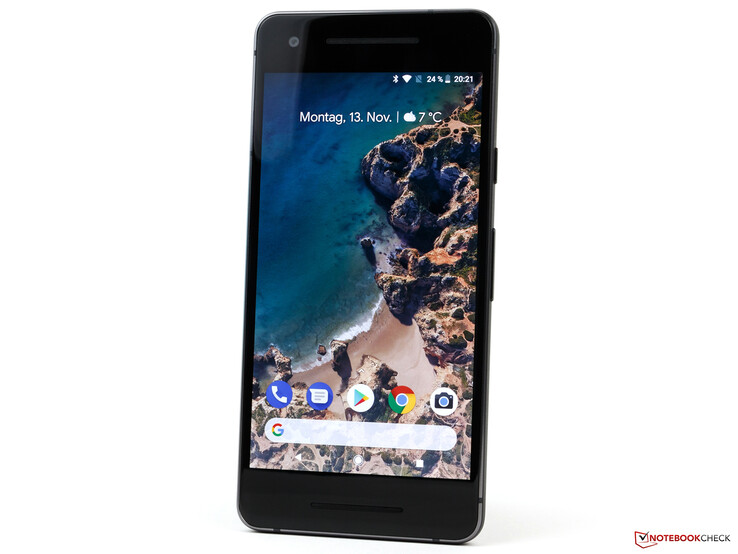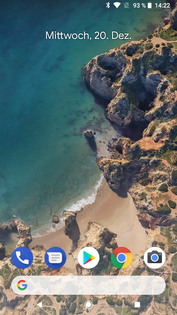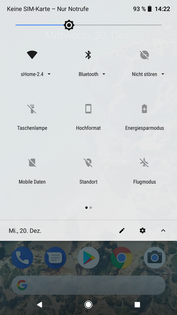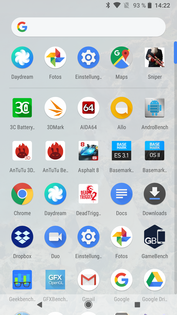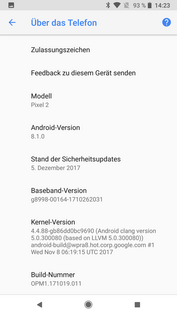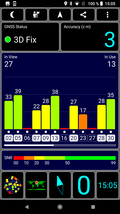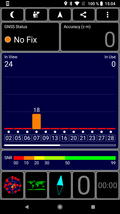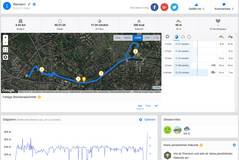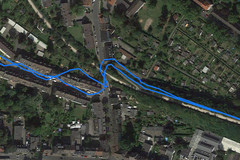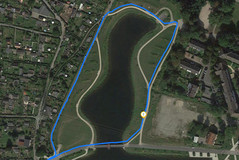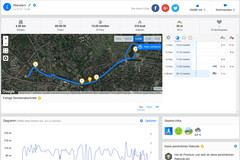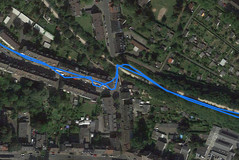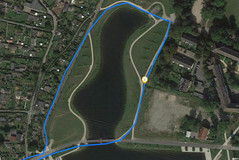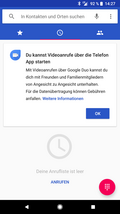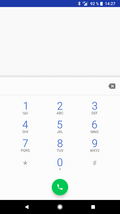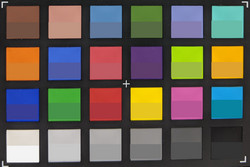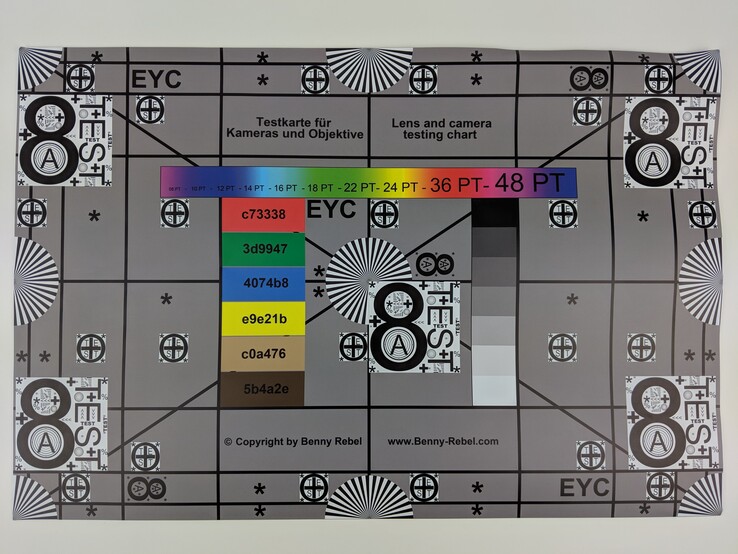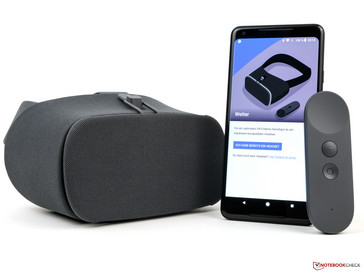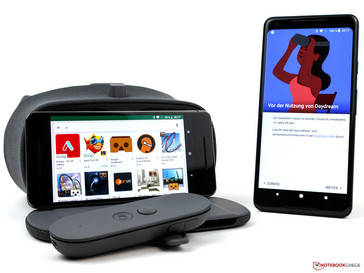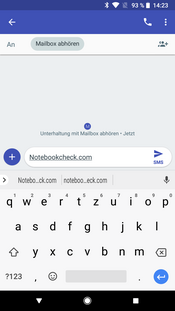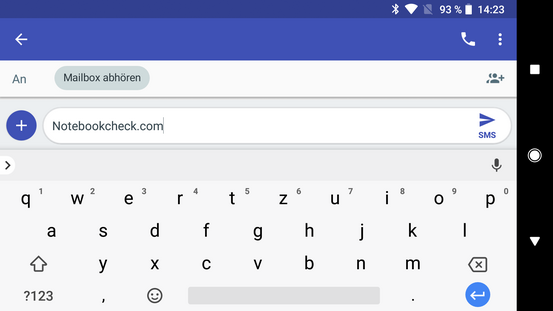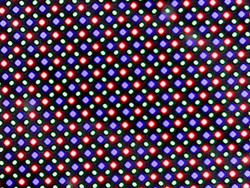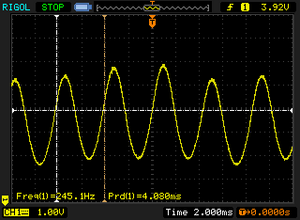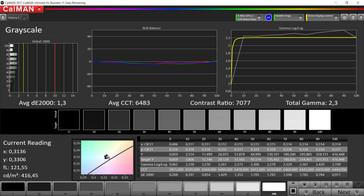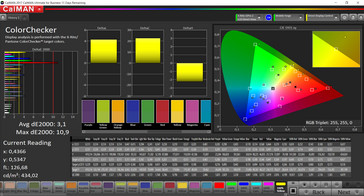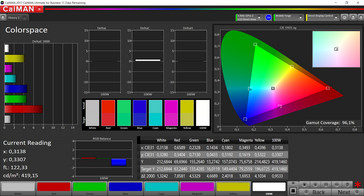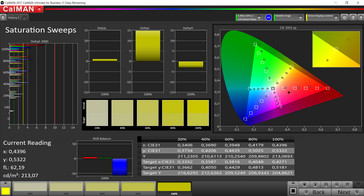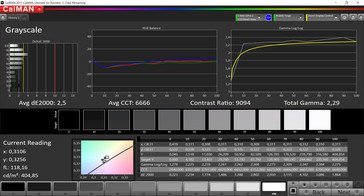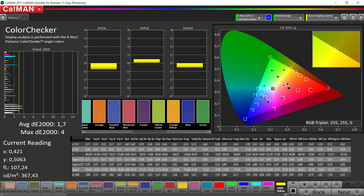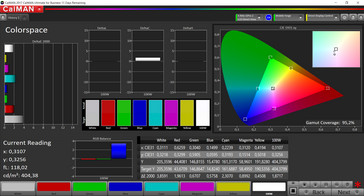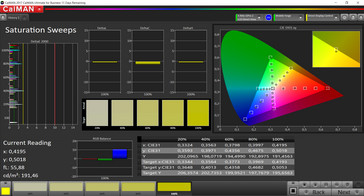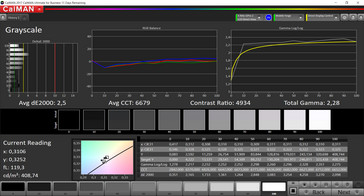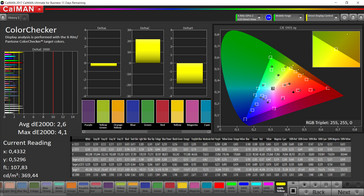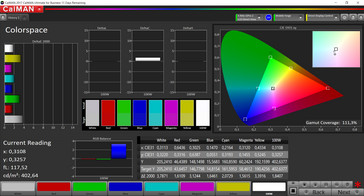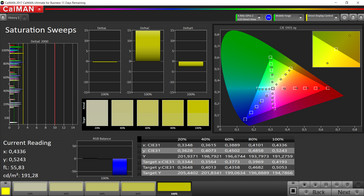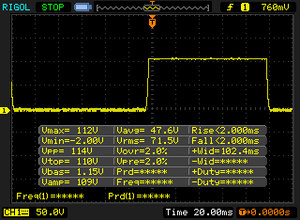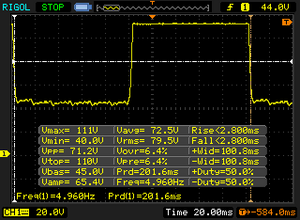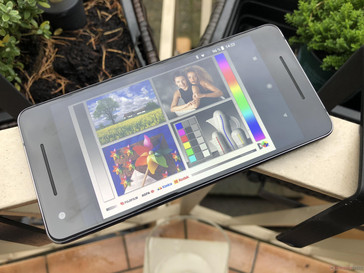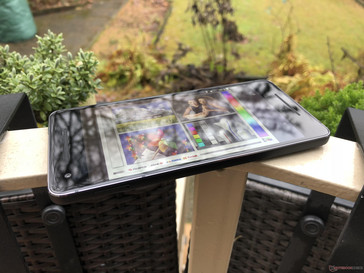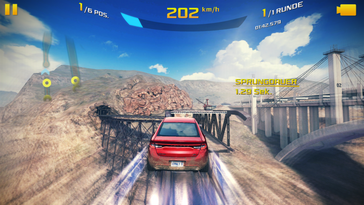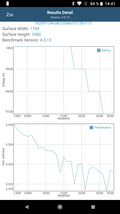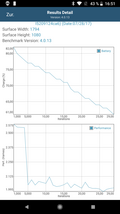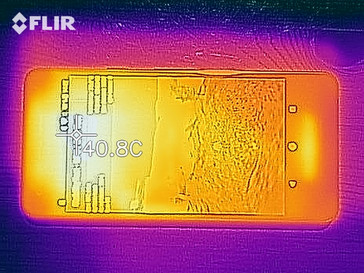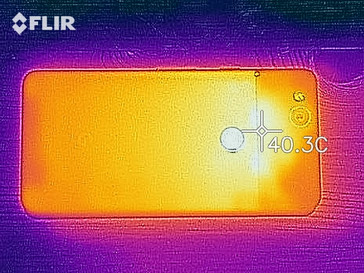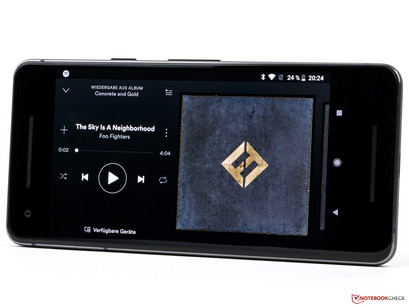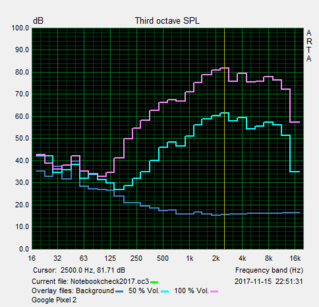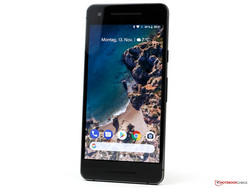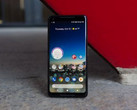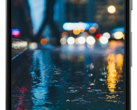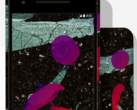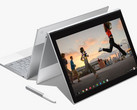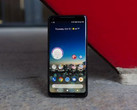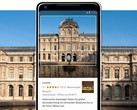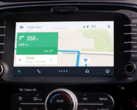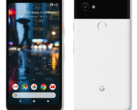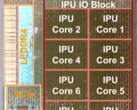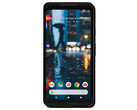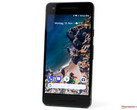Google Pixel 2 Smartphone Review
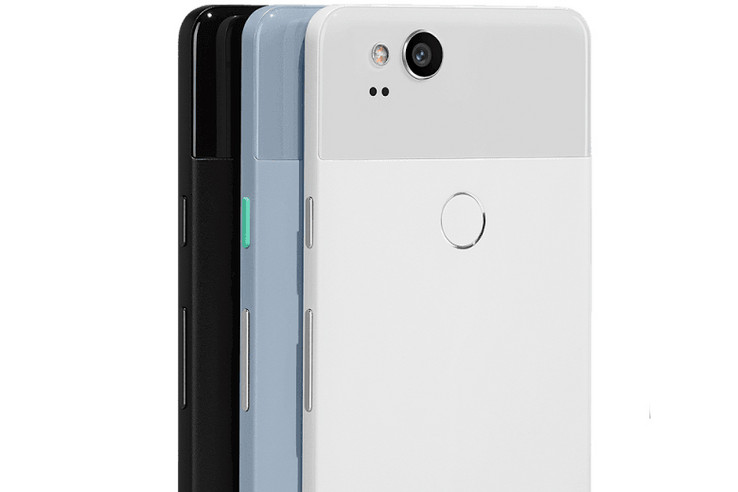
For the original German article, see here.
Google’s Pixel 2 follows its predecessor’s form factor and features a 5-inch 16:9 display, the exact same resolution as before, and even a battery that is once again 2,700 mAh in capacity. Its upgrades include more storage space on the base model, a new camera, and a fast Snapdragon 835 SoC. Regarding communication, its Wi-Fi (ac) and LTE (Cat. 15) modems are top-of-the line and leave nothing to be desired. As before, Google has forgone the MicroSD card slot for quick and affordable expandability. The two front-facing stereo speakers are a welcome change, and they work particularly well in landscape mode. Prices for the 5-inch Pixel 2 start at $649 (64 GB) with a $100 premium for the 128 GB model. As before, the Pixel 2 includes unlimited Google Drive cloud storage for full-size photos and videos taken with the device. Unlike before, this offer is now only temporary. The larger model called Pixel 2 XL differs mainly in display size and battery capacity, otherwise it is identical to the Pixel 2.
The Pixel 2’s competition is fierce and numerous. Among others, it competes with the Samsung Galaxy S8, Huawei P10, Apple iPhone 8, LG G6, Sony Xperia XZ, and Xiaomi Mi 6.
Case
In addition to weighing in at only 143 g (the lightest device in our test group), the 5-inch Google Pixel 2 appeared to be surprisingly small. The rear of the aluminum alloy case is partly covered with glass while at the front we find Corning Gorilla Glass 5.
The smartphone’s overall build quality is very high, and it turned out to be very rigid and resisted torsional forces with ease. Thanks to its underlying OLED technology, applying pressure to the display results in no visible ripple effect whatsoever. Gaps are consistent and tiny, and the device’s overall look and feel is impressive. Unfortunately, unlike on the XL the Pixel 2’s screen-to-body ratio is rather poor.
The NanoSIM slot sits flush with the case, and the smartphone is IP67 certified (dust tight, water-resistant). Strictly speaking, this means the phone can survive for up to 30 minutes in up to 1 meter of water. Consequently, the battery is not user-replaceable.
The Pixel 2 ships in three different colors: Black, White, and Blue. The latter comes with the same turquoise-colored power button we are already familiar with from the Huawei P10. Whether or not you like it is certainly going to be purely a matter of taste, but we did like it a lot.
Connectivity
In addition to the USB 3.1 Gen.1 Type-C port the Pixel 2 also supports NFC and Bluetooth 5.0. The latter includes support for aptX and aptX HD high-definition audio content.
As before, both Google smartphones come with unlimited Google Drive cloud storage for full-size photos and videos taken with the devices. Unlike before, this offer is temporary though, and it expires on January 15, 2021. After that you will be limited to high quality instead of full-size. According to Google, this offer renders MicroSD expansion futile, and for that reason, the phone lacks a MicroSD expansion slot.
Some other features it also lacks: infrared emitter/sensor, support for radio, and wireless charging.
Software
The Pixel 2 ships with Android 8.0 Oreo and will receive software and security updates through October 2020.
Additionally, the two new Pixel 2 phones are also the first ever to support Google Lens, which will be made available to other manufacturers at a later time as well. Lens uses Google’s massive server and computing infrastructure to analyze photos in order to recognize buildings, sceneries, works of art, books, and CD covers and provide you with additional information via Google Assistant. In addition, it also supports recognition of email addresses, postal addresses, and phone numbers off of flyers.
The phone also actively listens to its environment and presents you with singer and song title on its always-on display in case it detects and recognizes a song; a feature which can be disabled, though. Generally speaking, Google has plans to integrate its Google Assistant much deeper into the general Android user experience. For example, just like on the HTC U11, Google Assistant can be launched on the Pixel 2 by simply squeezing the phone.
The update to Android 8.1 Oreo is available since December 5th 2017.
Communication and GPS
Mobile Internet connections on the Google Pixel 2 are established via LTE Cat. 15 and numerous bands are supported. The Huawei Mate 10 Pro is currently the best smartphone in this respect if you require even more coverage. We used the Pixel 2 in the mobile networks of O2 as well as Vodafone, and we did not encounter any issues.
The smartphone supports the IEEE 802.11 standards a/b/g/n/ac in 2.4 as well as 5.0 GHz mobile networks. We can determine decent transfer rates in combination with our reference router Linksys EA8500, but the manufacturer waived the MIMO antenna technology this time, so the Pixel 2 cannot keep up with most of the rivals. This is hard to understand when you consider the high price. The dampening fluctuates between -34 and -44 dBm (2.4 GHz) and is increased to -79 up to -85 dBm (5.0 GHz) two storeys higher, but HD video streaming from YouTube was still smooth.
| Networking | |
| iperf3 transmit AX12 | |
| Samsung Galaxy S8 | |
| Xiaomi Mi 6 | |
| Sony Xperia XZ1 | |
| Apple iPhone 8 | |
| Huawei P10 | |
| Google Pixel 2 | |
| LG G6 | |
| iperf3 receive AX12 | |
| Apple iPhone 8 | |
| Xiaomi Mi 6 | |
| Sony Xperia XZ1 | |
| Samsung Galaxy S8 | |
| LG G6 | |
| Huawei P10 | |
| Google Pixel 2 | |
The spec sheet of the Google Pixel 2 lists support for the satellite networks GPS, Glonass, BeiDou, and Galileo. The satellite fix at the basement window did not work, but we got a signal within a couple of seconds outdoors with an accuracy down to 3 meters.
We had to perform our practical test by foot this time due to the bad weather, but we still compared the performance of the smartphone with the Garmin Edge 500. The overall deviation is surprisingly high at around 180 meters, and both devices are slightly next to the actual track in the area with many houses. A closer look at the recorded data shows the Pixel 2 does not locate the position as often as the professional device, so the accuracy drops. This is particularly noticeable around the lake, but there should not be any limitations for everyday navigation purposes.
Telephone Functions and Voice Quality
Google's phone app has a simple structure and not many features. The Pixel 2 also supports Voice over LTE (VoLTE) or Voice over WiFi (VoWifi), respectively, in general, but it requires support from the provider. This was not the case for O2 at the time of the review.
Subjectively, the voice quality is identical to the bigger Pixel 2 XL. It works well when you hold the smartphone to your ear: The voice of the other person is clear and easy to understand, while the Pixel user is a bit too quiet and appears to be quite far away. This impression is even enhanced when the speaker is active, which introduces some echoes. The sound from the Pixel is more artificial and less clear as well, so the overall impression is just average. The noise suppression is pretty reliable.
Cameras
The cameras are identical on both new Pixel 2 phones. At the front we find an 8 MP shooter with fixed focus and electronic image stabilization. Its nominal aperture of f/2.4 is quite common for front-facing cameras, however its large pixel size of 1.4 µm promises decent light sensitivity; which we found to be accurate during our tests at the launch event. Fortunately, the Pixel 2 supports its portrait mode feature that applies a bokeh effect to the background for selfies as well. The images are actually pretty convincing, even though the Portrait is quickly at its limit if the contours are uneven. The pictures are comparatively detailed and sharp.
The phone’s main rear-facing camera is referred to by Google as the best smartphone camera ever. Its 12.2 MP sensor with f/1.8 aperture and 1.4 µm large pixels is supported by laser autofocus and dual-pixel phase detection. The latter not only results in blazingly fast focusing - in combination with Google’s own machine learning algorithm it also means that portrait mode is supported despite the lack of a second camera. The results of the main camera are better for the portrait mode compared to the front cam. The daylight pictures generally capture many details with a decent dynamic range. The sharpness is on par with the Mate 10 Pro, while the iPhone X falls a bit behind. The Pixel 2 also performs well in low-light conditions and beats the two rivals noticeably; it performs even slightly better than the Galaxy Note 8. There is no criticism for the fast trigger speed, but the camera could include more features. You do not get a manual mode for the camera, and you cannot take RAW pictures, either.
The video mode is also light in terms of features. Users can only choose between three resolutions (UltraHD, FullHD, HD), all the other settings are handled by the camera. You get an optical as well as electronic image stabilization in return, which ensures smooth camera pans in particular.
We had a closer look at the camera performance of the Google Pixel 2 under controlled lighting conditions. We check the color performance with the ColorChecker Passport. Many colors are over-saturated, while the field for the light skin color suffers from a slight red hue.
The picture of the Test chart supports our impression of the sharp and detailed pictures. There is not much fray at the dark letters on the dark background, either, and the overall sharpness only takes a small hit towards the edges. All in all, the camera performance is very good.
Accessories, Warranty & Daydream View
Google ships the Pixel 2 with a two-year warranty, which cannot be extended. Please see our Guarantees, Return Policies & Warranties FAQ for country-specific information. The cope of delivery includes a so called Quick-Switch cable, which is supposed to make the smartphone switch easier, a modular power adapter (USB-C, 18W), a SIM tool as well as an audio adapter from USB to 3.5 mm stereo jack.
Google offers additional accessories for the smartphone on its website, especially covers, cables, and power adapters. We also received the current Google Daydream View (2017) for the review. Similar to all other VR headsets, it is important to put them directly in front of your eyes to avoid blurry areas. This works pretty well with the Daydream View after some practice, but you have to attach it firmly, otherwise it can easily move. The set-up is easy and the compact controller is comfortable to use. However, we would appreciate more content. The VR headset is not only compatible with the Pixel models, but also smartphones from other manufacturers. Google provides a list of compatible devices on its website.
Input Devices & Handling
Compared to the XL model, we actually prefer the gliding capabilities of the Google Pixel 2's 5-inch touchscreen, which recognizes up to ten inputs simultaneously. Inputs are executed quickly and very precisely. Google unsurprisingly uses its own GBoard keyboard layout, but you can also download and install any other layout from the Play Store.
The physical buttons for the volume as well as the power button are made of metal and they are sitting firmly in the chassis. Travel is short and the pressure points crisp, but the tactile feel is unfortunately identical except for the different size.
The fingerprint scanner at the back unlocks the smartphone reliably, but moist fingers will affect the detection rate. The input surface does not support additional gestures.
Display
Google equips the Pixel 2 with a comparatively small 5.0-inch display with a resolution of 1920 x 1080 pixels in a conventional 16:9 aspect ratio. The AMOLED screen is slightly darker than the POLED in the Pixel 2 XL, but the brightness distribution is better in return.
The display of the Pixel 2 is the darkest among the comparison, and the measurement with an even distribution of dark and bright surfaces (APL 50) does not change that, even though the result is better at 455 cd/m². Especially the Galaxy S8 (up to 800 cd/m²) and the Sony Xperia XZ1 are much brighter. You also get a blue light filter to protect the eyes as well as an always-on display.
The brightness of OLED panels is controlled via pulse-width modulation (PWM), and this is also the case for the Google Pixel 2. The amplitude characteristics is flat, but there can quickly be eye strain or even headaches for sensitive users.
| |||||||||||||||||||||||||
Brightness Distribution: 91 %
Center on Battery: 396 cd/m²
Contrast: ∞:1 (Black: 0 cd/m²)
ΔE ColorChecker Calman: 1.7 | ∀{0.5-29.43 Ø4.77}
ΔE Greyscale Calman: 1.3 | ∀{0.09-98 Ø5}
Gamma: 2.3
CCT: 6483 K
| Google Pixel 2 AMOLED, 1920x1080, 5" | Google Pixel 2 XL P-OLED, 2880x1440, 6" | Samsung Galaxy S8 Super AMOLED, 2960x1440, 5.8" | Apple iPhone 8 IPS True Tone, 1334x750, 4.7" | Sony Xperia XZ1 IPS, 1920x1080, 5.2" | Xiaomi Mi 6 IPS, 1920x1080, 5.2" | LG G6 IPS LCD, 2880x1440, 5.7" | Huawei P10 LTPS, 1920x1080, 5.1" | |
|---|---|---|---|---|---|---|---|---|
| Screen | -36% | -24% | 24% | -47% | -85% | -87% | -80% | |
| Brightness middle (cd/m²) | 396 | 415 5% | 566 43% | 604 53% | 620 57% | 620 57% | 646 63% | 547 38% |
| Brightness (cd/m²) | 404 | 420 4% | 564 40% | 580 44% | 610 51% | 586 45% | 611 51% | 556 38% |
| Brightness Distribution (%) | 91 | 87 -4% | 94 3% | 91 0% | 93 2% | 89 -2% | 89 -2% | 86 -5% |
| Black Level * (cd/m²) | 0.44 | 0.79 | 0.28 | 0.23 | 0.43 | |||
| Colorchecker dE 2000 * | 1.7 | 2.7 -59% | 2.7 -59% | 1.2 29% | 4.2 -147% | 4.8 -182% | 4.5 -165% | 4.8 -182% |
| Colorchecker dE 2000 max. * | 4 | 4.3 -8% | 5.4 -35% | 2.3 42% | 5.8 -45% | 8.8 -120% | 8.3 -108% | 8.8 -120% |
| Greyscale dE 2000 * | 1.3 | 3.3 -154% | 3.1 -138% | 1.6 -23% | 3.9 -200% | 5.3 -308% | 6 -362% | 4.5 -246% |
| Gamma | 2.3 96% | 2.36 93% | 2.15 102% | 2.25 98% | 2.02 109% | 2.25 98% | 2.27 97% | 2.39 92% |
| CCT | 6483 100% | 6787 96% | 6335 103% | 6688 97% | 7086 92% | 7473 87% | 7996 81% | 7194 90% |
| Color Space (Percent of AdobeRGB 1998) (%) | 81.57 | 67.74 | ||||||
| Color Space (Percent of sRGB) (%) | 99.87 | 99.05 | ||||||
| Contrast (:1) | 1373 | 785 | 2214 | 2809 | 1272 |
* ... smaller is better
Screen Flickering / PWM (Pulse-Width Modulation)
| Screen flickering / PWM detected | 245.1 Hz | ||
The display backlight flickers at 245.1 Hz (worst case, e.g., utilizing PWM) . The frequency of 245.1 Hz is relatively low, so sensitive users will likely notice flickering and experience eyestrain at the stated brightness setting and below. In comparison: 53 % of all tested devices do not use PWM to dim the display. If PWM was detected, an average of 8080 (minimum: 5 - maximum: 343500) Hz was measured. | |||
We check the display performance of the OLED panel in the Google Pixel 2 with the spectrophotometer and the professional software CalMAN. The measurements reveal accurate results for the colors and the grayscale, but the respective ideal results cannot be displayed simultaneously. The best color accuracy is available in the profile Natural, while the grayscale is ideal in the base setting (profile: Saturated). However, the picture quality of the Pixel 2 is also good in the other profiles. We can also determine the highest color gamut in the default setting.
Display Response Times
| ↔ Response Time Black to White | ||
|---|---|---|
| 4 ms ... rise ↗ and fall ↘ combined | ↗ 2 ms rise | |
| ↘ 2 ms fall | ||
| The screen shows very fast response rates in our tests and should be very well suited for fast-paced gaming. In comparison, all tested devices range from 0.1 (minimum) to 240 (maximum) ms. » 15 % of all devices are better. This means that the measured response time is better than the average of all tested devices (20.2 ms). | ||
| ↔ Response Time 50% Grey to 80% Grey | ||
| 5.6 ms ... rise ↗ and fall ↘ combined | ↗ 2.8 ms rise | |
| ↘ 2.8 ms fall | ||
| The screen shows very fast response rates in our tests and should be very well suited for fast-paced gaming. In comparison, all tested devices range from 0.165 (minimum) to 636 (maximum) ms. » 17 % of all devices are better. This means that the measured response time is better than the average of all tested devices (31.6 ms). | ||
The viewing angle stability of the Google Pixel 2 is noticeably better than compared to the XL model and the visible color cast appears later, but is still visible. There are no color inversions and the brightness drop from flat viewing angles is not too bad.
Performance
Google's Pixel 2 is equipped with Qualcomm's current high-end SoC: the Snapdragon 835. It is supported by 4 GB LPDDR4x RAM and you can choose between 64 or 128 GB internal storage. Graphics calculations are handled by the Qualcomm Adreno 540.
The test model is particularly impressive in the system benchmarks and beats all the rivals including the bigger sibling in PCMark. The vanilla Android solution has a positive effect and ensures a very fast system launch (just seven seconds) since version 8.1 Oreo. The CPU performance is on the expected level, just like the results in the GPU benchmarks. There are no major outliers and the test model is only clearly beaten by the iPhone in some tests.
| AnTuTu v6 - Total Score (sort by value) | |
| Google Pixel 2 | |
| Google Pixel 2 XL | |
| Huawei P10 | |
| Samsung Galaxy S8 | |
| LG G6 | |
| Apple iPhone 8 | |
| Xiaomi Mi 6 | |
| Sony Xperia XZ1 | |
| PCMark for Android | |
| Work performance score (sort by value) | |
| Google Pixel 2 | |
| Google Pixel 2 XL | |
| Huawei P10 | |
| Samsung Galaxy S8 | |
| LG G6 | |
| Xiaomi Mi 6 | |
| Sony Xperia XZ1 | |
| Work 2.0 performance score (sort by value) | |
| Google Pixel 2 | |
| Google Pixel 2 XL | |
| Huawei P10 | |
| Samsung Galaxy S8 | |
| LG G6 | |
| Xiaomi Mi 6 | |
| Sony Xperia XZ1 | |
| Geekbench 4.4 | |
| 64 Bit Single-Core Score (sort by value) | |
| Google Pixel 2 | |
| Google Pixel 2 XL | |
| Huawei P10 | |
| Samsung Galaxy S8 | |
| LG G6 | |
| Apple iPhone 8 | |
| Xiaomi Mi 6 | |
| Sony Xperia XZ1 | |
| 64 Bit Multi-Core Score (sort by value) | |
| Google Pixel 2 | |
| Google Pixel 2 XL | |
| Huawei P10 | |
| Samsung Galaxy S8 | |
| LG G6 | |
| Apple iPhone 8 | |
| Xiaomi Mi 6 | |
| Sony Xperia XZ1 | |
| Compute RenderScript Score (sort by value) | |
| Google Pixel 2 | |
| Google Pixel 2 XL | |
| Huawei P10 | |
| Samsung Galaxy S8 | |
| LG G6 | |
| Sony Xperia XZ1 | |
| GFXBench (DX / GLBenchmark) 2.7 | |
| T-Rex Onscreen (sort by value) | |
| Google Pixel 2 | |
| Google Pixel 2 XL | |
| Huawei P10 | |
| Samsung Galaxy S8 | |
| LG G6 | |
| Apple iPhone 8 | |
| Xiaomi Mi 6 | |
| Sony Xperia XZ1 | |
| 1920x1080 T-Rex Offscreen (sort by value) | |
| Google Pixel 2 | |
| Google Pixel 2 XL | |
| Huawei P10 | |
| Samsung Galaxy S8 | |
| LG G6 | |
| Apple iPhone 8 | |
| Xiaomi Mi 6 | |
| Sony Xperia XZ1 | |
| GFXBench 3.0 | |
| on screen Manhattan Onscreen OGL (sort by value) | |
| Google Pixel 2 | |
| Google Pixel 2 XL | |
| Huawei P10 | |
| Samsung Galaxy S8 | |
| LG G6 | |
| Apple iPhone 8 | |
| Xiaomi Mi 6 | |
| Sony Xperia XZ1 | |
| 1920x1080 1080p Manhattan Offscreen (sort by value) | |
| Google Pixel 2 | |
| Google Pixel 2 XL | |
| Huawei P10 | |
| Samsung Galaxy S8 | |
| LG G6 | |
| Apple iPhone 8 | |
| Xiaomi Mi 6 | |
| Sony Xperia XZ1 | |
| GFXBench 3.1 | |
| on screen Manhattan ES 3.1 Onscreen (sort by value) | |
| Google Pixel 2 | |
| Google Pixel 2 XL | |
| Huawei P10 | |
| Samsung Galaxy S8 | |
| LG G6 | |
| Apple iPhone 8 | |
| Xiaomi Mi 6 | |
| Sony Xperia XZ1 | |
| 1920x1080 Manhattan ES 3.1 Offscreen (sort by value) | |
| Google Pixel 2 | |
| Google Pixel 2 XL | |
| Huawei P10 | |
| Samsung Galaxy S8 | |
| LG G6 | |
| Apple iPhone 8 | |
| Xiaomi Mi 6 | |
| Sony Xperia XZ1 | |
| GFXBench | |
| on screen Car Chase Onscreen (sort by value) | |
| Google Pixel 2 | |
| Google Pixel 2 XL | |
| Huawei P10 | |
| Samsung Galaxy S8 | |
| LG G6 | |
| Xiaomi Mi 6 | |
| Sony Xperia XZ1 | |
| 1920x1080 Car Chase Offscreen (sort by value) | |
| Google Pixel 2 | |
| Google Pixel 2 XL | |
| Huawei P10 | |
| Samsung Galaxy S8 | |
| LG G6 | |
| Xiaomi Mi 6 | |
| Sony Xperia XZ1 | |
| Lightmark - 1920x1080 1080p (sort by value) | |
| Google Pixel 2 | |
| Google Pixel 2 XL | |
| Huawei P10 | |
| Samsung Galaxy S8 | |
| LG G6 | |
| Xiaomi Mi 6 | |
| Basemark X 1.1 | |
| Medium Quality (sort by value) | |
| Huawei P10 | |
| Samsung Galaxy S8 | |
| LG G6 | |
| High Quality (sort by value) | |
| Huawei P10 | |
| Samsung Galaxy S8 | |
| LG G6 | |
| Xiaomi Mi 6 | |
| Basemark ES 3.1 / Metal - offscreen Overall Score (sort by value) | |
| Google Pixel 2 | |
| Google Pixel 2 XL | |
| Huawei P10 | |
| Samsung Galaxy S8 | |
| LG G6 | |
| Xiaomi Mi 6 | |
| Epic Citadel - Ultra High Quality (sort by value) | |
| Huawei P10 | |
| Samsung Galaxy S8 | |
| LG G6 | |
| Xiaomi Mi 6 | |
Web browsing is a smooth experience on the Google Pixel 2 and even complex websites are quickly loaded. The benchmark results are average, only the Mozilla Kraken score is comparatively low and at the bottom of the comparison group.
| JetStream 1.1 - Total Score | |
| Apple iPhone 8 | |
| Xiaomi Mi 6 (Chrome Version 58) | |
| Samsung Galaxy S8 (Samsung Browser 5.2) | |
| Google Pixel 2 (Chrome 62) | |
| Sony Xperia XZ1 (Chrome 61) | |
| Huawei P10 (Chrome 56) | |
| LG G6 (Chrome 57) | |
| Octane V2 - Total Score | |
| Apple iPhone 8 | |
| Samsung Galaxy S8 (Samsung Browser 5.2) | |
| Xiaomi Mi 6 (Chrome Version 58) | |
| Google Pixel 2 (Chrome 62) | |
| Huawei P10 (Chrome 56) | |
| Sony Xperia XZ1 (Chrome 61) | |
| LG G6 (Chrome 57) | |
| Mozilla Kraken 1.1 - Total | |
| Google Pixel 2 (Chrome 62) | |
| Sony Xperia XZ1 (Chrome 61) | |
| Huawei P10 (Chrome 56) | |
| Xiaomi Mi 6 (Chrome Version 58) | |
| LG G6 (Chrome 57) | |
| Samsung Galaxy S8 (Samsung Browser 5.2) | |
| Apple iPhone 8 | |
| WebXPRT 2015 - Overall | |
| Apple iPhone 8 | |
| Samsung Galaxy S8 (Samsung Browser 5.2) | |
| Google Pixel 2 (Chrome 62) | |
| Sony Xperia XZ1 (Chrome 61) | |
| Huawei P10 (Chrome 56) | |
| LG G6 (Chrome 57) | |
* ... smaller is better
Google's Pixel 2 is shipped with modern UFS 2.1 storage. All the benchmark results are very good, only the writing performance of small data blocks is not so great. Especially the Huawei P10 is better in this respect.
You can either get a 64 or 128 GB version of the Google Pixel 2. After the initial launch of our 64 GB model, we still had about 55 GB at our disposal. Similar to the previous model, you get unlimited storage for your own pictures and videos in Google's cloud. However, this service is a bit limited by now and only allows the storage of original quality pictures until January 15th 2021. All pictures will be limited to "high quality" after this date.
| Google Pixel 2 | Huawei P10 | Samsung Galaxy S8 | LG G6 | Xiaomi Mi 6 | Sony Xperia XZ1 | |
|---|---|---|---|---|---|---|
| AndroBench 3-5 | 184% | -10% | -33% | 5% | -8% | |
| Sequential Read 256KB (MB/s) | 758 | 738 -3% | 793 5% | 428.7 -43% | 728 -4% | 679 -10% |
| Sequential Write 256KB (MB/s) | 196.2 | 189.8 -3% | 193.2 -2% | 122.8 -37% | 196.7 0% | 204.4 4% |
| Random Read 4KB (MB/s) | 173.1 | 168.4 -3% | 127.2 -27% | 95.2 -45% | 143.5 -17% | 156.6 -10% |
| Random Write 4KB (MB/s) | 18.03 | 152.3 745% | 15.25 -15% | 16.58 -8% | 25.19 40% | 14.93 -17% |
| Sequential Read 256KB SDCard (MB/s) | 54.2 ? | 63.9 ? | 77.6 ? | 65.5 ? | ||
| Sequential Write 256KB SDCard (MB/s) | 32.19 ? | 53.5 ? | 53.3 ? | 47.71 ? |
Games
The graphics unit Adreno 540 in the Google Pixel 2 is very fast and supports all modern graphics APIs. All titles from the Play Store run smoothly at the highest quality settings, which is supported by our benchmarks.
The two front-facing speakers are well positioned, but you can easily cover them with the hands in landscape mode. Both the sensors as well as the touchscreen are very precise and do not cause any criticism.
| Asphalt 8: Airborne | |||
| Settings | Value | ||
| high | 30 fps | ||
| very low | 30 fps | ||
| Dead Trigger 2 | |||
| Settings | Value | ||
| high | 60 fps | ||
Emissions
Temperature
The surface temperatures of the Google Pixel 2 are very low and completely uncritical (mostly lukewarm) even under load. Only a couple of spots surpass 38 °C.
Inside, however, the situation is more heated during the GFXBench battery test. The T-Rex test, which uses the graphics API OpenGL ES 2.0, does not show any. This changes in the more challenging Manhattan test. The performance already drops after four runs by up to 22%, but the limitations should not be perceptible in practice.
(+) The maximum temperature on the upper side is 38.2 °C / 101 F, compared to the average of 35.2 °C / 95 F, ranging from 21.9 to 247 °C for the class Smartphone.
(+) The bottom heats up to a maximum of 36.9 °C / 98 F, compared to the average of 34 °C / 93 F
(+) In idle usage, the average temperature for the upper side is 26.3 °C / 79 F, compared to the device average of 32.9 °C / 91 F.
Speakers
Similar to the Pixel 2 XL, our test model has two front-facing speakers, which are supposed to create high-quality stereo sound. The specs are identical to the speakers in the XL, but our Pink Noise measurement shows that the speakers of the Google Pixel 2 are not as balanced as on the bigger sibling. They still sound pretty good in practice and can become really loud at up to 89 dB(A).
There is unfortunately no stereo jack, so you either need USB-C headphones or the provided adapter for wired headphones. A pair of Bluetooth headphones is the better solution because the Pixel models support aptX HD.
Google Pixel 2 audio analysis
(+) | speakers can play relatively loud (89.4 dB)
Bass 100 - 315 Hz
(-) | nearly no bass - on average 27% lower than median
(±) | linearity of bass is average (8% delta to prev. frequency)
Mids 400 - 2000 Hz
(±) | reduced mids - on average 5.6% lower than median
(+) | mids are linear (5.3% delta to prev. frequency)
Highs 2 - 16 kHz
(±) | higher highs - on average 5.3% higher than median
(+) | highs are linear (4.7% delta to prev. frequency)
Overall 100 - 16.000 Hz
(±) | linearity of overall sound is average (20% difference to median)
Compared to same class
» 32% of all tested devices in this class were better, 9% similar, 59% worse
» The best had a delta of 11%, average was 35%, worst was 134%
Compared to all devices tested
» 50% of all tested devices were better, 8% similar, 41% worse
» The best had a delta of 4%, average was 24%, worst was 134%
Sony Xperia XZ1 audio analysis
(±) | speaker loudness is average but good (80.9 dB)
Bass 100 - 315 Hz
(-) | nearly no bass - on average 31.2% lower than median
(±) | linearity of bass is average (11.6% delta to prev. frequency)
Mids 400 - 2000 Hz
(+) | balanced mids - only 4.4% away from median
(+) | mids are linear (6.8% delta to prev. frequency)
Highs 2 - 16 kHz
(+) | balanced highs - only 2.8% away from median
(+) | highs are linear (4.4% delta to prev. frequency)
Overall 100 - 16.000 Hz
(±) | linearity of overall sound is average (24.2% difference to median)
Compared to same class
» 56% of all tested devices in this class were better, 7% similar, 36% worse
» The best had a delta of 11%, average was 35%, worst was 134%
Compared to all devices tested
» 72% of all tested devices were better, 6% similar, 22% worse
» The best had a delta of 4%, average was 24%, worst was 134%
Apple iPhone 8 audio analysis
(±) | speaker loudness is average but good (78.4 dB)
Bass 100 - 315 Hz
(±) | reduced bass - on average 14.6% lower than median
(±) | linearity of bass is average (9.2% delta to prev. frequency)
Mids 400 - 2000 Hz
(+) | balanced mids - only 4.3% away from median
(+) | mids are linear (4.2% delta to prev. frequency)
Highs 2 - 16 kHz
(±) | higher highs - on average 5.1% higher than median
(+) | highs are linear (4.7% delta to prev. frequency)
Overall 100 - 16.000 Hz
(±) | linearity of overall sound is average (18.2% difference to median)
Compared to same class
» 18% of all tested devices in this class were better, 8% similar, 74% worse
» The best had a delta of 11%, average was 35%, worst was 134%
Compared to all devices tested
» 38% of all tested devices were better, 8% similar, 54% worse
» The best had a delta of 4%, average was 24%, worst was 134%
Frequency Comparison (Checkboxes select/deselectable!)
Battery Runtime
Power Consumption
The Google Pixel 2 has a 2700 mAh battery, which can be charged within 106 minutes with the provided power adapter. Qualcomm's QuickCharge is supported, but wireless charging is not.
Similar to the Pixel 2 XL, the power consumption is high while idling. The smartphone pulls about 1W from the power adapter when all consumers are deactivated and the display is dimmed. The Xperia XZ1 only consumed about half of that, so Google still has some work to do here.
| Off / Standby | |
| Idle | |
| Load |
|
Key:
min: | |
| Google Pixel 2 2700 mAh | Samsung Galaxy S8 3000 mAh | Apple iPhone 8 1821 mAh | LG G6 3300 mAh | Huawei P10 3200 mAh | Sony Xperia XZ1 2700 mAh | Xiaomi Mi 6 3350 mAh | |
|---|---|---|---|---|---|---|---|
| Power Consumption | 13% | 5% | -14% | -42% | -42% | -3% | |
| Idle Minimum * (Watt) | 0.99 | 0.78 21% | 0.54 45% | 0.62 37% | 0.83 16% | 0.51 48% | 0.45 55% |
| Idle Average * (Watt) | 1.35 | 1.1 19% | 1.63 -21% | 1.43 -6% | 2.1 -56% | 2.16 -60% | 1.67 -24% |
| Idle Maximum * (Watt) | 1.37 | 1.16 15% | 1.67 -22% | 1.48 -8% | 2.18 -59% | 2.23 -63% | 1.69 -23% |
| Load Average * (Watt) | 3.25 | 4.15 -28% | 2.74 16% | 5.52 -70% | 6.57 -102% | 7.45 -129% | 4.07 -25% |
| Load Maximum * (Watt) | 8.56 | 5.12 40% | 7.78 9% | 10.47 -22% | 9.32 -9% | 9.28 -8% | 8.54 -0% |
* ... smaller is better
Battery Runtime
As expected, the battery runtime is not great, but you should still be able to cover one day with a full charge. However, you will have to charge it sooner if you take a lot of pictures or play the occasional game.
The Google Pixel 2 is at the back of the comparison group and the runtime is much lower compared to the Pixel 2 XL, especially under load. We also had the chance to test the Google Pixel 2 with both Oreo versions. We used the WLAN test for a direct comparison, which is executed at an adjusted luminance of 150 nits. The Pixel 2 actually manages almost the same runtime running Android 8.1 Oreo and only loses 13 minutes compared to the old version.
Once the battery runs low, you can activate the power-save mode (manually or automatically), which will limit the functionality of the smartphone to the essentials.
| Google Pixel 2 2700 mAh | Samsung Galaxy S8 3000 mAh | Apple iPhone 8 1821 mAh | Huawei P10 3200 mAh | LG G6 3300 mAh | Xiaomi Mi 6 3350 mAh | Sony Xperia XZ1 2700 mAh | |
|---|---|---|---|---|---|---|---|
| Battery runtime | 35% | 16% | 21% | 34% | 28% | 6% | |
| Reader / Idle (h) | 24.3 | 27.8 14% | 27.2 12% | 25.7 6% | 29.8 23% | 26.9 11% | |
| H.264 (h) | 9.4 | 12.9 37% | 11.6 23% | 9.7 3% | 13 38% | 9.7 3% | |
| WiFi v1.3 (h) | 9.6 | 12 25% | 9.8 2% | 16.1 68% | 11.5 20% | 12.3 28% | 10 4% |
| Load (h) | 2.7 | 4.4 63% | 3.4 26% | 2.9 7% | 4.2 56% | 2.9 7% |
| PCMark for Android - Work 2.0 battery life | |
| Huawei Mate 10 Pro | |
| Google Pixel 2 | |
| Google Pixel 2 XL | |
| Samsung Galaxy S8 | |
| HTC U11 | |
Pros
Cons
Verdict
Google’s focus for and main selling point of its latest smartphones is the combination of hardware, software, and artificial intelligence that these two constitute. The Google Pixel 2 is certainly a very good smartphone, even though the design is a little bit outdated.
Contrary to the XL model, the smartphone provides decent viewing angles. However, this display is also comparatively dark, which cannot be compensated by the excellent contrast on bright days. We cannot understand why Google dropped the MIMO technology for the 2017 models, either, because the WLAN performance is much lower as a result.
The Google Pixel 2 has a slightly outdated design, but comes with a lot of great technology.
One of the highlights is the camera of the Pixel 2, which leaves a great impression in all lighting conditions and Google Lens is a great additional feature. It is also laudable that the smaller model does not get a worse camera sensor. The rating is a bit lower due to the missing Pro mode and the lack of video features, but we think the pure picture quality of the Pixel 2 is even slightly ahead of Samsung's Galaxy S8 models.
The long update cycle (until October 2020) of the new Pixel models is another major advantage. If you plan on using the device for a long time and want a compact smartphone with a modern OS, the Pixel 2 is hard to ignore.
Google Pixel 2
- 12/20/2017 v6 (old)
Daniel Schmidt


